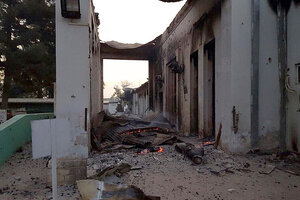Why did US attack an Afghan hospital? Kunduz's troubling questions.
The US's goal of zero civilian casualties went badly wrong at a Médecins Sans Frontières hospital in Kunduz, leaving US officials to try to piece together why their efforts to protect civilians failed.

The burned Doctors Without Borders hospital is seen after explosions in the northern Afghan city of Kunduz, Saturday.
Doctors Without Borders/AP
On one hand, the United States is being accused of being too scared of civilian casualties to take the fight to the Islamic State in Syria and Iraq.
On the other, the US is being accused of razing a hospital in Kunduz, Afghanistan, killing 19 – including three children – and even continuing the attack for 30 minutes after being told what the building was.
Though the picture from Afghanistan is incomplete and shifting, both statements appear to be true. At least three investigations into the Kunduz attack have been promised, and the French aid group that ran the hospital, Médecins Sans Frontières (Doctors Without Borders), has been relentless in demanding answers.
But more broadly, the episode raises new and pressing questions about how an airstrike could go so horribly wrong at a time when the stated goal of the Obama administration is zero civilian casualties. At best, it was a terrible mistake that illustrates how thin the line can be between waging war with a modicum of morality and committing what could be a war crime. At worst, it shows how even the most careful policies can be undermined by fast-moving events on the ground.
Recent examples show how hard the goal of limiting civilian casualties is for countries trying to wage an effective air campaign.
In June, a US airstrike destroyed an Iraqi factory building bombs for the Islamic State – and in the process "flattened an entire neighborhood," killing 70, including civilians, Reuters reported. In January, a Canadian jet killed between six and 27 civilians in Iraq – but Canadian authorities "felt no obligation under the Geneva Conventions to probe what happened," the Toronto Globe and Mail reported. Meanwhile, Saudi airstrikes killed at least 364 civilians in Yemen during the first three weeks of an air campaign against rebel militias earlier this year, according to United Nations statistics.
The US has won praise from advocacy groups for its attempts to limit civilian casualties in airstrikes against the Islamic State. “The US has indeed put in place rigorous policies and procedures to minimize civilian harm,” Federico Borello, executive director of the Center for Civilians in Conflict, told The New York Times.
Yet in the fight against the Islamic State and the Taliban, the pressure for results is keen. Billions of dollars and thousands of lives have been lost, and yet the Taliban still took Kunduz from Afghan forces last week, and the Islamic State only gains more recruits.
Noting that as much as three-quarters of American warplanes sent on sorties against the Islamic State return without having dropped a bomb, GOP Sen. John McCain told The Hill that such an excess of caution "is insane," adding that “the air campaign is totally ineffectual.”
Former Pentagon official Michèle Flournoy, once tipped to be Defense secretary, wrote in The Washington Post that the air campaign in Iraq and Syria should be intensified, with "forward air controllers to call in close air support."
Over the weekend, Defense officials said US troops deployed in Kunduz had made the call for the airstrike. On Monday, however, the Pentagon's top officer contradicted those reports and said Afghan troops had called for the airstrike after taking fire from the building – a claim Doctors Without Borders rejects emphatically.
The Pentagon's admission could raise questions about the reliability of coalition partners.
Afghan special forces had had a run-in with Doctors Without Borders in July, raiding the hospital in contravention of international law when they learned that an Al Qaeda operative was being treated there. They objected to the aid group's promise to give care to any who need it.
Indeed, as fighting around Kunduz between the Taliban and Afghan security forces intensified in recent months, Doctors Without Borders remained, even increasing its number of beds. When a local man had to care for two men injured in the fighting, he told the Los Angeles Times: “It's the name everyone in the north knows, so I thought they would be in good hands there.”
After the airstrike, Doctors Without Borders left Kunduz.
Afghan officials, often eager to condemn the US for civilian casualties, have instead been supportive. In war, “you have two choices: either continue operations to clean up, and that might involve attacks in public places, or you just let the Taliban control," an Afghan member of parliament, Fawzia Koofi, told The Washington Post.
Doctors Without Borders objected to this line of reasoning.
In a statement, the group said it "is disgusted by the recent statements coming from some Afghanistan government authorities justifying the attack on its hospital in Kunduz. These statements imply that Afghan and US forces working together decided to raze to the ground a fully functioning hospital with more than 180 staff and patients inside because they claim that members of the Taliban were present. This amounts to an admission of a war crime."
War crimes include attacking "buildings dedicated to ... charitable purposes ..., provided they are not military objectives," according to the Red Cross.
Doctors Without Borders adds that it has repeatedly given the coordinates of the building to military officials to avoid such a tragedy. It says it contacted officials during the middle of the hourlong strike to ask for the attack to be called off. Now, it is asking for an independent investigation.
At a time when the US is trying to push the boundaries of humane warfare, the Kunduz attack could offer poignant lessons about those limits.

